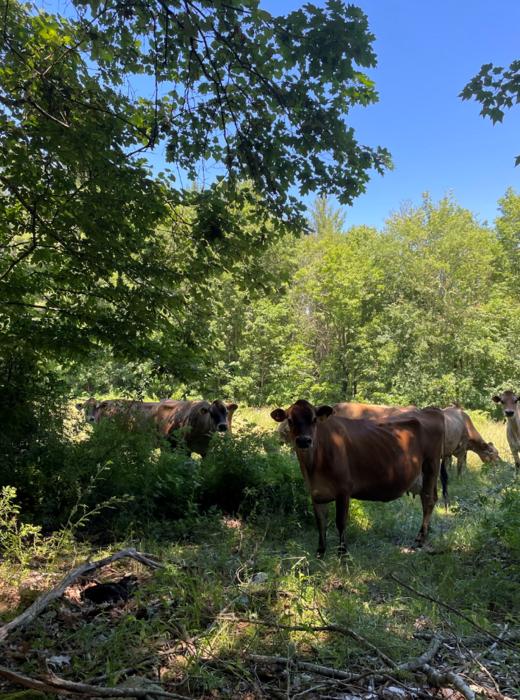DURHAM, N.H.—The University of New Hampshire will use a $10 million grant from the United States Department of Agriculture (USDA) to develop more sustainable ways to implement climate-smart agriculture (CSA) strategies to expand farming and food production while enhancing economic opportunities, providing important ecosystem services like clean water and air and creating healthy communities in New England.

Credit: University of New Hampshire
DURHAM, N.H.—The University of New Hampshire will use a $10 million grant from the United States Department of Agriculture (USDA) to develop more sustainable ways to implement climate-smart agriculture (CSA) strategies to expand farming and food production while enhancing economic opportunities, providing important ecosystem services like clean water and air and creating healthy communities in New England.
“Approximately 75% of New England is made up of forests which can be challenging when trying to expand farming opportunities to meet the growing need for more sustainable ways to produce locally grown food,” said Heidi Asbjornsen, professor of natural resources and the environment and principal investigator for the project. “But those forests also need to be preserved because they are a globally important carbon sink that absorbs and stores about 4.6 billion tons of carbon dioxide each year. We’re looking to develop ways to expand agriculture opportunities while also preserving that carbon storage which is crucial when addressing climate change.”
The five-year project, titled Promoting Climate-Smart Sustainable Agriculture in New England through Regionally Adapted Agroforestry Systems, is known as ADAPT. It will study agroforestry—the practice of integrating crop and animal farming in forested areas—to blend the two farming strategies into one united solution that reduces impacts on ecosystems and balances sustainable agriculture with climate mitigation, adaptation and resilience.
ADAPT will focus on three types of agroforestry suitable for the New England landscape:
- silvopastures, which combines trees, pastures and livestock on the same land to provide multiple goods and services;
- polycultures, which refers to systems that integrate trees and shrubs with diverse non-woody plant species to promote interactions that can increase productivity and resilience in urban food-forests and home gardens—examples include alley cropping, windbreaks and buffers along waterways that can protect nearby rivers, streams and wetlands;
- forest farming systems, where intermediate-to high-shade tolerant crops are cultivated beneath a forest canopy so landowners can harvest timber as well as non-timber products, including medicinal plants, tree syrups, mushrooms and other wild edible and floriculture crops.
In the long term, researchers anticipate that this project will contribute to increasing local food production in New England by 15% and annual carbon sequestration by five million tons; will foster new agroforestry market opportunities; and will enhance New England’s capacity to balance food production with the benefits that forests provide.
“Other regions in the country have done similar research on agroforestry but there really hasn’t been a lot of related research here in New England which makes it challenging to make informed decisions,” said Asbjornsen. “One of our goals with this project is to establish a center for agroforestry research, education, and extension, which would also offer a training program in agroforestry for landowners, producers, managers, educators and other decision makers focused on adapting agroforestry practices to the New England landscape.”
UNH will partner with Dartmouth College and Yale University to bring a range of complementary resources and expertise. The three-prong approach is to co-develop, implement and evaluate climate resilient agroforestry systems. UNH’s Cooperative Extension forestry and agricultural teams will provide training and technical support in agroforestry practices across diverse populations. Researchers will provide education to enhance knowledge of agroforestry as a climate-smart strategy to mitigate greenhouse gas emissions, increase market opportunities and enhance regionally appropriate climate adaptation and resilience.
Co-principal investigators include Steve Roberge, Alexandra Contosta and Kate Guerdat, all from UNH; Theresa Ong from Dartmouth University; and Mark Ashton from Yale University.
The University of New Hampshire inspires innovation and transforms lives in our state, nation and world. Nearly 16,000 students from 50 states and 87 countries engage with an award-winning faculty in top-ranked programs in business, engineering, law, health and human services, liberal arts and the sciences across more than 200 programs of study. A Carnegie Classification R1 institution, UNH partners with NASA, NOAA, NSF, and NIH, and received over $210 million in competitive external funding in FY23 to further explore and define the frontiers of land, sea and space.
IMAGES FOR DOWNLOAD
LINK:
CAPTION: Cows graze in the shade of a silvopasture, an example of agroforestry, that UNH researchers visited this summer to conduct field assessments to help inform the design of the new agroforestry systems that will be implemented next summer as part of the USDA project.
PHOTO CREDIT: University of New Hampshire
CAPTION: This area of forest at UNH’s Organic Dairy Research Farm was recently thinned as the first step towards creating a silvopasture—one type of agroforestry which combines trees, pastures and livestock on the same land. Once grasses are established, the heifers will be able to graze among the trees. For now, they are enjoying their new environment with more shade.
PHOTO CREDIT: University of New Hampshire



